Manchester Pusher: Does a serial killer haunt the city's canals?
- Published
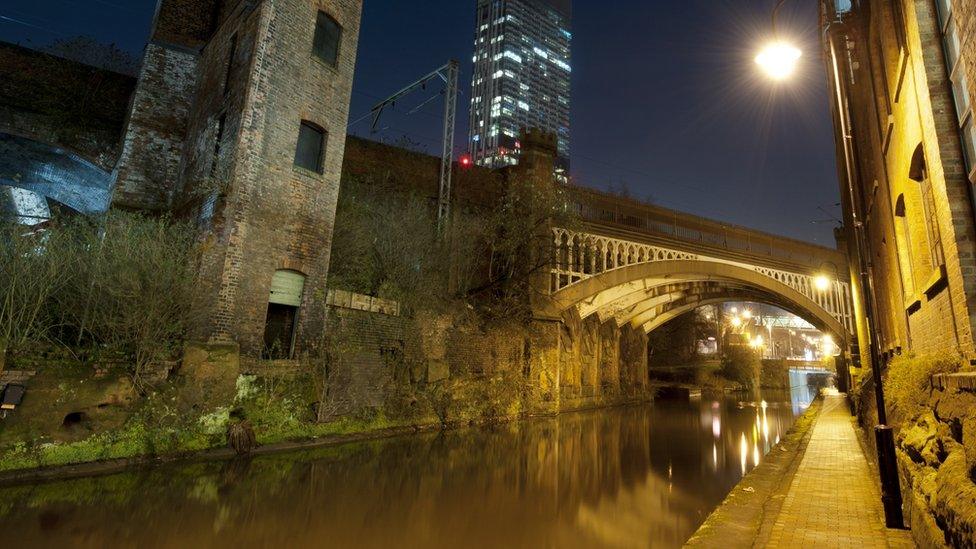
Rumours of a serial killer stalking Manchester's canals have spread around the world, despite repeated denials from those in law enforcement. So what is the truth behind the story of 'The Pusher'?
Tom was cycling home at night when the man attacked him. A swinging arm knocked the 34-year-old into the cold, black water of the Bridgewater Canal. Shocked by what had happened, Tom tried to pull himself out, but the man kicked his hand away.
"I started to think 'This is quite serious'," says Tom', who asked that his real name not be published.
He had heard rumours about "The Pusher", a supposed serial killer whose victims were found drowned in Manchester's old industrial canals. There are no lights along that section of canal towpath, running through the south-west of the city. No-one to hear him if he screamed.
Eventually, Tom managed to haul himself out of the water. Following the assault, which took place in April, the city's police and coroner denied there was any evidence of a serial attacker.
Yet dozens of dead bodies have been pulled from the city's waterways over the past decade and the rumours remain.
Manchester canal death sites mapped
The history of "The Pusher" can be traced back to 11 January 2015 when the Daily Star Sunday published a two-page article, external headlined "Manchester's Killer Canals".
It cited 61 deaths in the city's waterways over the past six years and quoted a psychologist, Prof Craig Jackson, saying "perhaps we are talking about a canal killer". The canals, he said, were "popular dumping sites" for bodies.
Since then, the number of reported deaths has grown, to 76, then 80, then 86, in different newspapers. What is rarely mentioned is that these figures refer not to the city itself but to Greater Manchester, an urban area covering hundreds of square miles which also includes towns several miles from Manchester, such as Bolton, Rochdale and Wigan.
Figures from the Manchester City Area coroner's office show there have in fact been 35 drownings over the past decade. Greater Manchester Fire and Rescue Service (GMFRS) say there have been 22 such deaths in the city centre since 2009.
Greater Manchester Police (GMP) said it had since met Prof Jackson "to clarify and correct" his information. When contacted by BBC News, he was reluctant to discuss the cases.
Despite this, interest in "The Pusher" shows no sign of slowing. The story has made headlines worldwide and similar reports have emerged of alleged killers feared to be operating in Yorkshire, external, Bristol, external and London., external
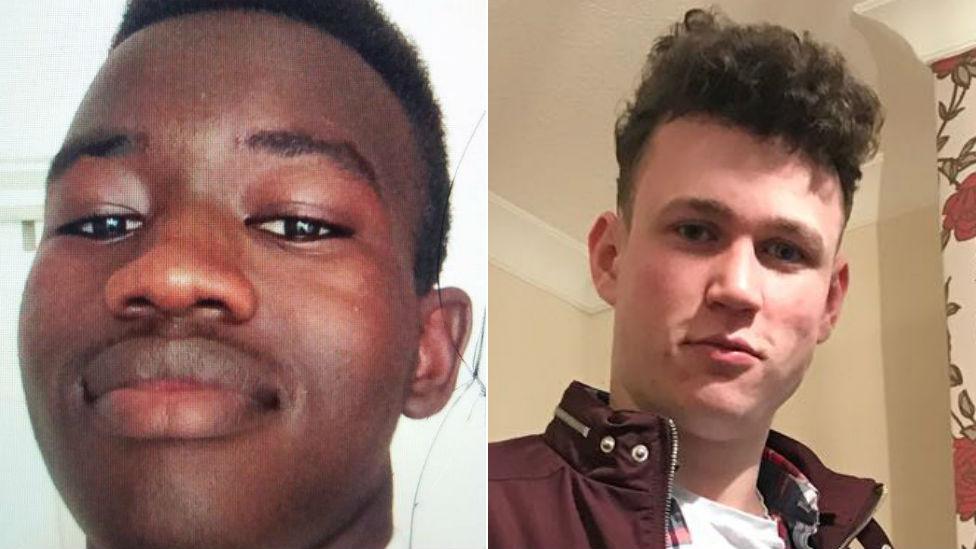
Teenagers Orlando Nyero and Charlie Pope both died in Manchester's canals this year
"People enjoy consuming stories like these… there does seem to be this insatiable appetite for real-life serial killers," says Prof Elizabeth Yardley, a criminologist who is also a colleague of Prof Jackson at Birmingham City University.
One possible cause, she says, is the apparent mystery still surrounding the deaths.
Of the 35 recorded drownings, 10 resulted in "open" verdicts. This means the authorities could not prove what caused them. Five more of the deaths are subject to ongoing investigations.
Certainly some of those who drowned in the city's canals suffered violent deaths.
In 2013, 40-year-old Simon Brass died after being pushed into a city centre canal by muggers. Five people were later jailed for their part in this attack.
The following year an attempted robbery ended when the attacker fell into the same canal and died.
But these cases are a minority.
BBC analysis of the 10 open verdicts revealed there were no suspicious circumstances in at least three of them. The families of two other people who drowned told the BBC they believed their loved ones either took their own lives or died in an accident.
The BBC has found no evidence of any further violent attacks.

The Rochdale Canal next to Canal Street in Manchester. Four bodies have been recovered from the water here in the past decade
GMP has said "speculation" surrounding the deaths has been made without "examination of all the facts and evidence". It said it would reinvestigate if "new credible evidence comes to light".
Tom says he is "disappointed" with the police response and said the canals were the perfect place for crime.
"It's pitch black down there," he said. "There's no lights. You look up, someone catches your eye and then in four seconds you're in dirty water."
There are about 10 miles of canals running through central Manchester, dating back to the city's industrial heyday in the 18th and 19th Centuries. Take a tour of them today and you can see how much Manchester has changed.
In the city centre, people spill out from the bars and clubs lining a stretch of the Rochdale Canal where 16 people have died over the past decade.
Here, new apartment blocks are being built close to the waterside, where the detritus of several great nights out can be found; empty spirits bottles, take-away boxes, cigarette butts and condoms.
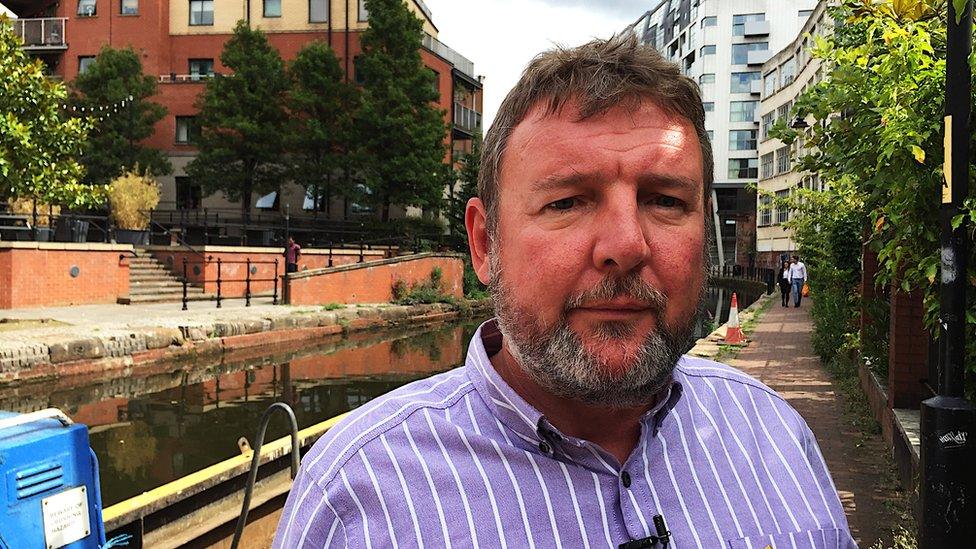
Nick Pope, standing at the site where the body of his son Charlie was recovered
Standing beside the canal, Nick Pope looks at the place where his son Charlie's body was recovered from the water in March.
"Look around here, it's just a bloody death trap," he says, as people drink outside at tables a few metres from the water's edge.
Charlie, who was 19 and in his first year at university, had been drinking on the night of his death, Mr Pope said. However, he believes poor lighting and lack of safety infrastructure also played a part.
A photograph taken by police when Charlie drowned shows snow and ice on the canal towpath. A short fence has since been put in place at the site beneath the steps down from the pub garden.

Photograph taken by Greater Manchester Police, showing the site where Charlie Pope's body was recovered in March
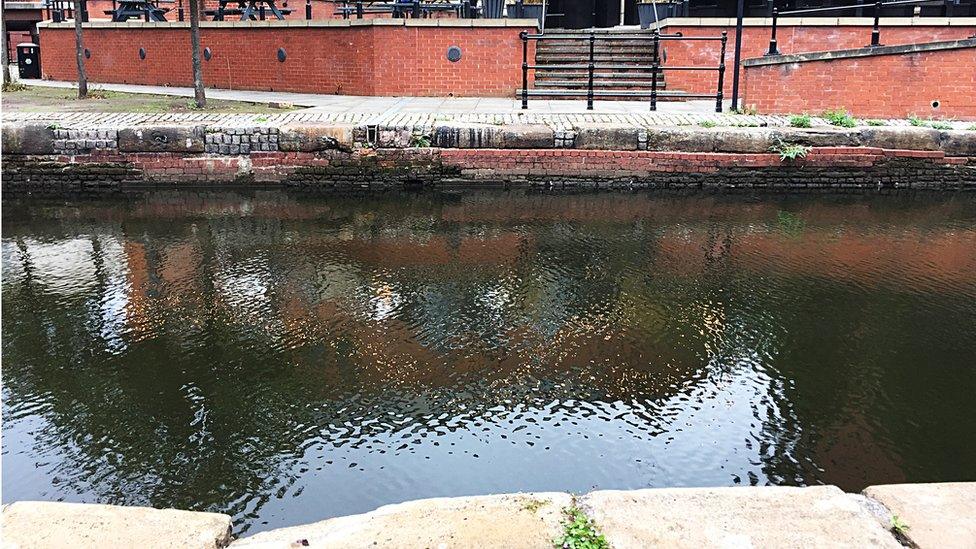
A barrier has now been put in place along the canal
Three months later another 19-year-old, Orlando Nyero, drowned a few hundred metres further down the same stretch of water.
Orlando's brother, Sam Abui, was with him that night and says they had been celebrating a birthday in the city.
"The police said it was an accident. It was a tragic accident," he said. Thirteen other deaths in Manchester's waterways over the past decade have also been found to have been the result of accidents or misadventures.
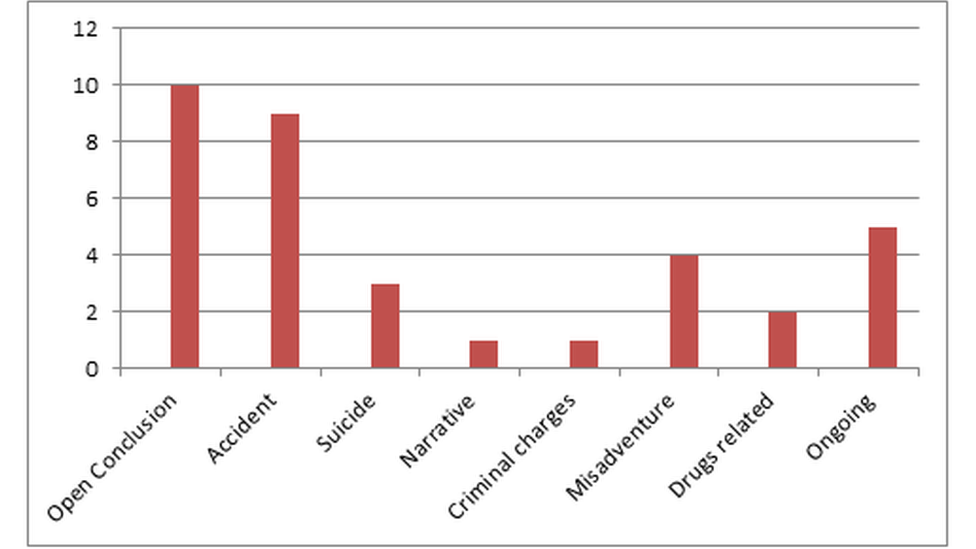
Coronial verdicts on the causes of death in Manchester's canals and waterways from 2008-2018. Source: HM Coroner's office
"I suspect that a significant number of these deaths are alcohol-related," says David Wilson, the chair of the Manchester Water Safety Partnership.
Standing near where Orlando's body was recovered, he looks up at the bars lining the canal.
"We are losing too many young lives tragically and we desperately want to do something about that."
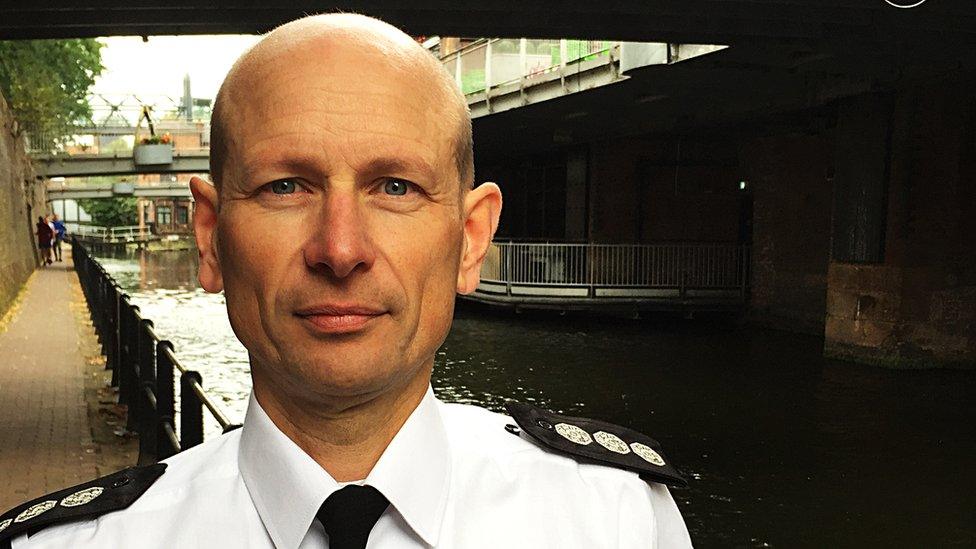
Manchester Water Safety Partnership chair David Wilson, near where the body of Orlando Nyero was recovered
Since Charlie's death, almost 100,000 people have signed a petition calling for barriers to be erected along the city's canals. The Water Safety Partnership has also commissioned the Royal Society for the Prevention of Accidents (RoSPA) to survey Manchester's canal system, with the results expected later this month.
One likely indicator of what this might find is a recent study carried out in Amsterdam, external, another city where the network of canals runs right through the centre, between people's homes, and bars and clubs.
The study's lead author, forensic doctor Guido Reijnen, says most of those who drown are young men.
"That's not specific to Amsterdam, it's something specific to men," says Dr Reijnen. "In all kinds of accidents, men are always over-represented. Men are more likely to be risk-takers. More likely to walk home alone at night."

You might also be interested in:
The Dutch study also contains other clues to what may be happening in Manchester. Many drownings happen on Saturday night and Sunday morning. More than half of those who died had been drinking or taking drugs. Ten per cent of the men's bodies recovered from the water were found with their zips open.
As a result, Amsterdam's police and fire services are now deploying their resources to what Dr Reijnen calls "hot times and hot spots" when drownings are more likely. The city is also installing ladders and other safety infrastructure to the canals themselves.
In Manchester, coroners investigating deaths in the canals have repeatedly warned that future drownings will happen if similar work is not done in the city.

Regulation 28 report warning future deaths might occur if action is not taken following the death of Caspar Blackburn in 2017
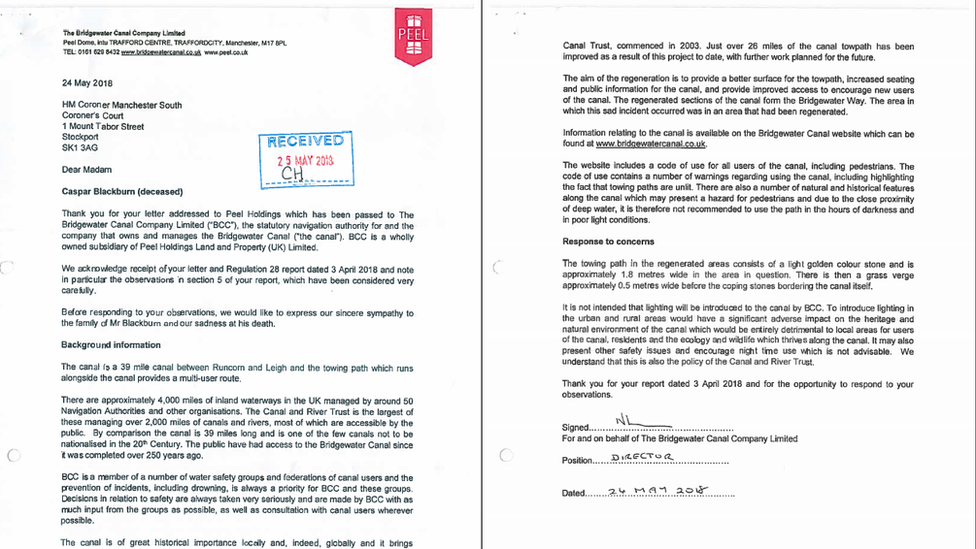
Letter sent by the Bridgewater Canal Company, saying "it is not intended that lighting will be introduced"
The most recent of these, external highlighted poor lighting along the Bridgewater Canal following the death of 22-year-old Caspar Blackburn in October last year.
However, the Bridgewater Canal Company declined to introduce waterside lighting, citing its impact on the "heritage and natural environment".
It has, though, upgraded the towpath to make it safer for cyclists following the death of 39-year-old Catherine Sharman in 2011.
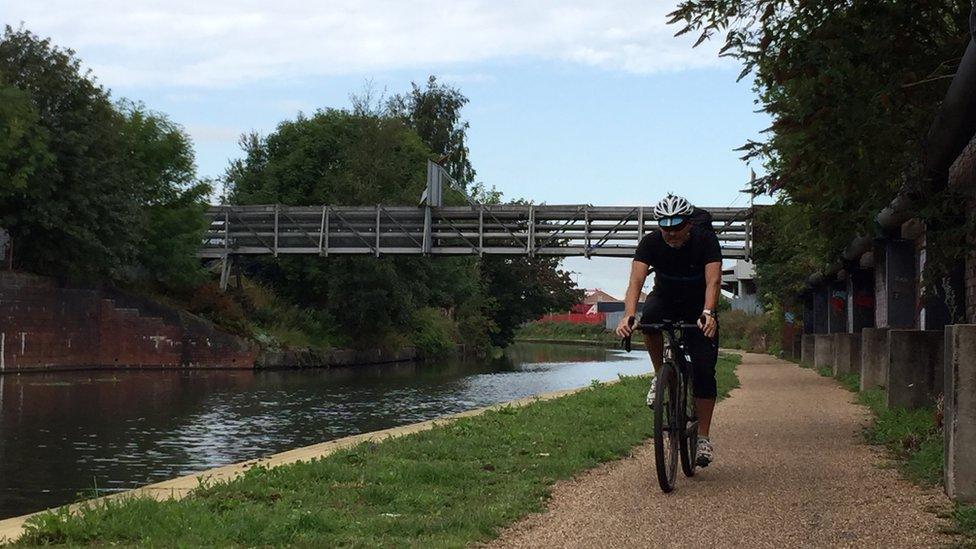
A cyclist uses the Bridgewater Canal towpath, close to where the body of Catherine Sharman was recovered
The Canal & Rivers Trust, which manages around 2,000 miles of waterways across the country, also received a formal Regulation 28 notice, external from a coroner in 2016, warning about the lack of safety equipment or signs at a canal lock in the city following the death of 13-year-old Flavio Rafael Pizarro, external.
The charity says "no swimming" signs have since been erected and it plans to install a throw line at the site soon.
Both Peel Holdings, which owns the Bridgewater Canal Company, and the Canals & Rivers Trust are also members of the Manchester Water Safety Partnership.
Its chair, Mr Wilson, says speculation about "The Pusher" has at least helped raise awareness of the number of deaths in the city's canals.
But in other ways, he says, it has prevented the safety message hitting home.
"What hasn't been beneficial is people misunderstanding what the true situation is."
Additional reporting by Nicola Corrigan and Mia Gair.
You can see this story in full on BBC Inside Out North West via iPlayer.
- Published7 June 2018

- Published27 May 2018
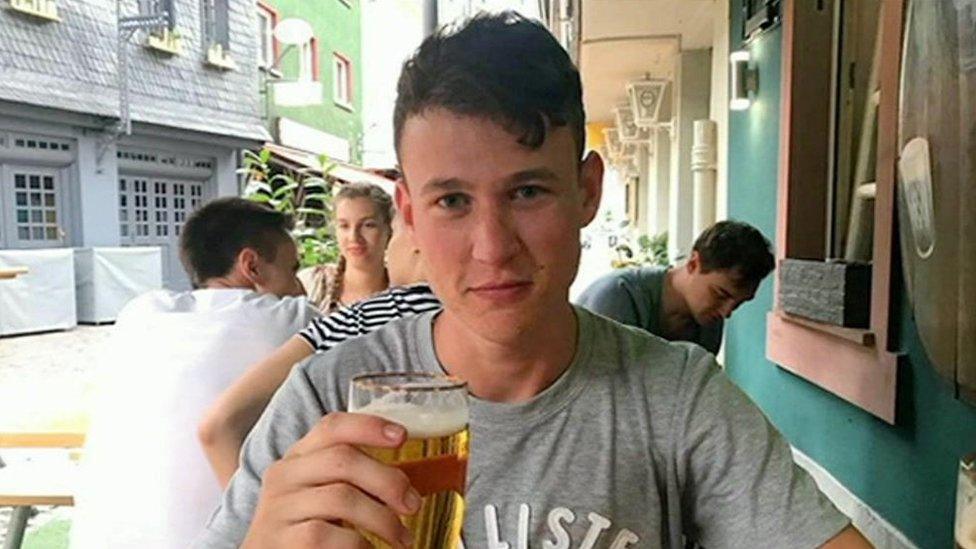
- Published6 March 2018
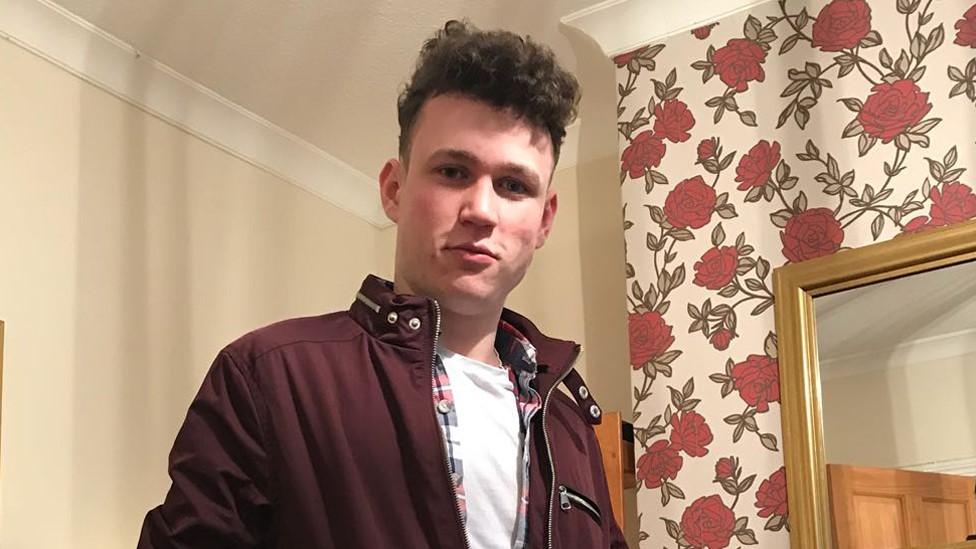
- Published7 October 2017

- Published14 June 2016
